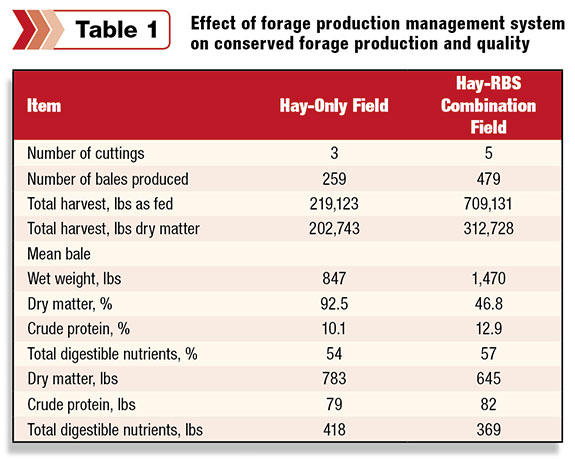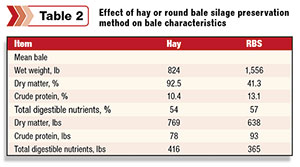Conservation of forage provides feed and nutritional resources to meet cow nutritional requirements during annual deficits in pasture forage production to maintain adequate cow productivity.
Round bale silage (RBS) offers an alternative method of forage harvesting and storage to traditional hay harvest and storage.
Traditional hay harvest systems require optimal cutting, drying and baling weather conditions. The use of round bale silage can offer an attractive complement to traditional hay harvest systems.
Certainly, RBS offers several advantages. A primary advantage is that RBS can mitigate adverse weather and drying conditions for hay production.
Incorporation of a RBS system increases the flexibility of the forage harvest window. Sequential days of dry weather are not required for the conservation of forage in the RBS system.
This flexibility allows for the timely harvest of forages to capture forage nutrients before they are lost due to maturity or weathering.
Additionally, RBS does not require as much drying time as hay; therefore, less plant material is lost due to processing and handling.
Appropriate preservation dry matter targets for hay (approximately 85 percent) and RBS (approximately 50 percent) should be utilized.
Excessive moisture in either hay or RBS will increase the opportunity for spoilage and ultimately decrease the quality and consistency of the conserved forage.
Because it protects silage from weathering, an RBS system may retain more of the nutrients in the forage than a traditional system. Finally, RBS-conserved forage maintains its quality out-of-doors; thus no hay barn structures are required.
Application
A demonstration was conducted at the Santa Fe-Boston Farm Beef Research Unit located in northern Alachua County, Florida. A 50-acre Tifton-85 bermudagrass field was divided into two 25-acre sections.
One section was managed to produce hay only. Forage was harvested as large round hay bales (five-foot diameter) as growing conditions and weather permitted. The other section was managed on a four-week harvest schedule.
Forage was harvested and stored as large round hay bales when weather/drying conditions permitted. When weather did not allow for harvest as hay, forage was harvested and stored as RBS.
The hay-only section was fertilized four times (one 90 pounds N per acre, three 80 pounds N per acre) from April through August; the hay-RBS section received five applications of fertilizer (one 90 pounds N per acre, three 80 pounds N per acre and one 68 pounds N per acre) because an additional forage harvest occurred.
Hay production typically required three to four days of drying time with one to two rakings to facilitate dry-down of the forage. The RBS was baled in a similar manner to dry hay using a large round baler.
It was preserved with an Anderson in-line hay wrapper. Production of RBS utilized a three-hour to four-hour wilting time between cutting and baling and no raking.
Bales for RBS were wrapped within two hours of baling. Hay and RBS bale weights and core samples were collected on every 10th bale produced on the day of harvest.
Analysis of hay and RBS samples was performed by Dairy One NIRS analysis. This analysis provided detailed information about bale dry matter, protein, total digestible nutrients, fiber fractions and other nutrients.
Bale weights were obtained after baling and either prior to storage as hay or RBS. Total number of bales was recorded at each harvest to calculate total pounds of forage harvested for each system.
Outcome
More cuttings of forage were taken from the hay-RBS field, which was managed to remove forage on a regular interval compared to the hay field (Table 1).
The increase in the number of cuttings resulted in an increased total number of bales, total wet forage harvested and total forage dry matter harvested from the hay-RBS compared to the hay-only production system.
The hay-RBS section included one cutting of forage that was harvested as hay.
Mean bale weight produced from the hay-RBS section was 42 percent greater than mean bale weight from the hay section.
Forage dry matter was very different between the two harvest sections because of the large portion of forage harvested as RBS.
Hay section bale dry matter was 45.7 units greater than bales produced from the hay-RBS section. Mean bale crude protein (CP) and total digestible nutrient (TDN) percentage were greater for forage harvested from the hay-RBS section compared to the hay section.
When expressed on a dry matter basis, mean bale weight and bale TDN supply was greater for the hay section than the hay-RBS section. However, mean bale CP amount did not differ between the two harvest systems.
When the forage conservation method (hay versus RBS) was examined, mean bale weight was greater for RBS than for hay bales (Table 2).
This is a result of the lower dry matter percentages associated with RBS compared with hay.
Additionally, CP and TDN percentages for bales produced during the summer harvest period were greater for RBS bales than for hay bales.
In contrast, greater mean hay bale dry matter yield and TDN yield occurred in hay bales compared to hay RBS, but CP yield did not differ. The improvement in hay CP and TDN percentages between hay bales from the hay-RBS section were slightly greater in quality compared to hay- only because of the regular harvest schedule that helped to capture forage quality through managing forage maturity.
Management of forage maturity mitigates the increases in fiber fractions, decrease in protein concentration and increase in stem:leaf ratio as grasses grow and mature.
A common misconception is that the ensiling process that RBS undergoes improves the nutritive value of the RBS product. In fact, the nutritive value of the forage is set when the forage is harvested; wrapping RBS just preserves what is present in the forage.
Any forage conservation system will benefit from analysis to quantify the economic parameters of hay and RBS production.
This analysis should include comparisons between hay and RBS cost of production and the cost benefit to producing and storing high-quality stored forage.
The different production inputs for hay and RBS (number of raking, baling costs and fertilizer applications) and differing costs for these production inputs will drive production cost differences.
Additionally, the number and size of hay or RBS bales produced will affect total production costs; more and larger bales spread production costs over more output, thus decreasing the production costs per unit produced (i.e., tons of forage, bales).
Summary
Harvesting forage as round bale silage works very well as an alternative to traditional hay harvest. Forage harvest can occur on a regular schedule to optimize forage quantity and quality.
To optimize the investment in round bale silage production, harvest forage at its nutritional peak to capture superior quality and to increase production.
Additionally, the decreased storage loss associated with round bale silage improves the economic viability of round bale silage as a complement or alternative to hay production. FG
Todd Thrift and Joel Yelich are associate professors with the Department of Animal Sciences, University of Florida.
References omitted due to space but are available upon request. Click here to email an editor.
—Excerpts from University of Florida extension website
Dr. Matt Hersom
Extension Beef Cattle Specialist
University of Florida











